by Tomi Nagai-Rothe
I led a group in meditation/worship at the beginning of a gentle movement workshop for Friends.* Without thinking, I took the group of 18 people into Um. After the session a participant came up to ask, “Is this group especially good at getting into deep meditation?” I remember thinking “That’s just Um.” I didn’t want to take too much credit, but I mentioned that it’s possible to lead a group into a deep meditation.
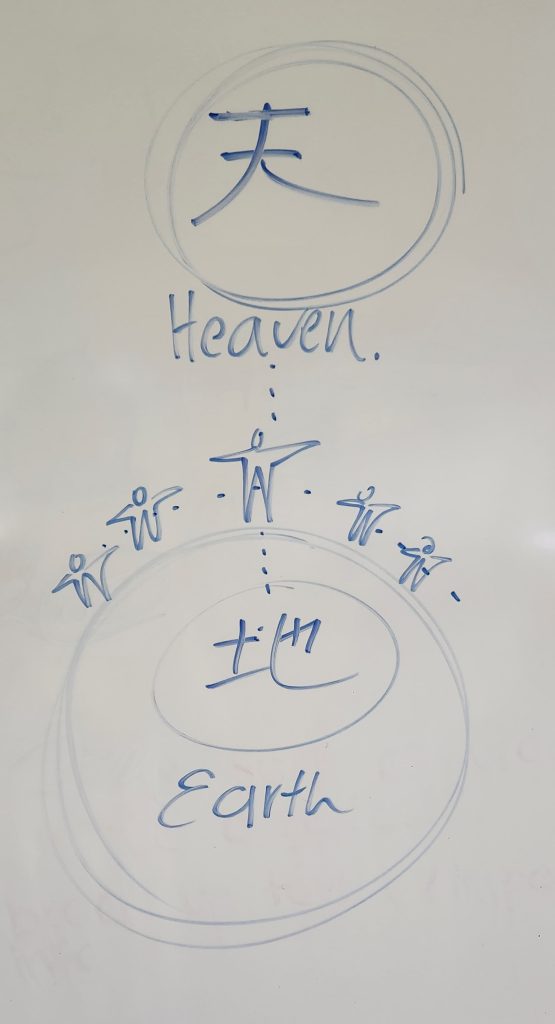
Friends spend a great deal of time in silence: it’s a familiar place to be. We also try to be attentive to those around us. That is where keiko and Friends’ culture overlaps. It hadn’t occurred to me how attentive to gorei a group of Friends could be.
In July I traveled to Western Oregon University in Monmouth, Oregon to lead a five-day workshop (2.5 hours per day) entitled, “Gentle Movement for Traumatic Times.” The workshop was inspired by two F/friends who had survived serious illness and were unable to find accessible movement classes. Beyond that, I had heard many stories from Friends of the Global Majority who had been traumatized by insensitive interactions with white/European-American Friends. I wanted to both create a welcoming space and to share traditional martial arts tools from Shintaido to work with stress and conflict.
Over the five days I shared Panic/Rock/Wakame/Bamboo solo and with partners; Wakame kumite; Soto Irimi – stepping in; Sagari Irimi – dubbed “Welcome, This Way Please” by Ito; Tenshingoso and a simple leading/following kumite.
I shared Panic/Rock/Wakame/Bamboo as options for addressing stressful interactions. The main point was knowing when to let things go and go with the flow (wakame) or to stand firm (bamboo). People had a chance to think about situations in which they wished they had had these tools, and current situations in which they could practice them.
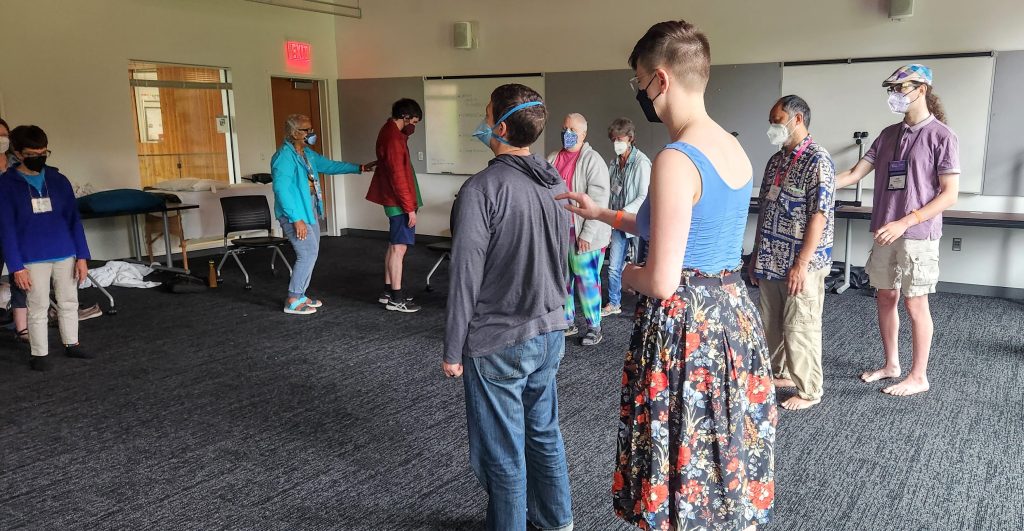
I was really glad that everyone took to kumite so quickly and took good care of their partners. It makes me think that I don’t often consider the deep opportunities that kumite really offers. It really can be a door to liberation that I cannot access alone.
I knew I wanted to share Soto Irimi – simply stepping in and changing the plane of one’s body to be closer to an attacker. In the 1990s I was working closely with a talented woman I call my mentor/tormentor. I learned strategy from her and much more, but she moved fast, was intense and had huge demands. Eventually, I felt like she was coming at me full speed like a freight train. One evening I told this story to Lee Seaman in my kitchen and she had me stand up and pretend that she was my tormentor. She said, “Try stepping in.”
Stepping in and changing the plane of my body made all the difference. That practice helped me survive the next three years. I no longer felt like I had to be plastered by someone coming at me.
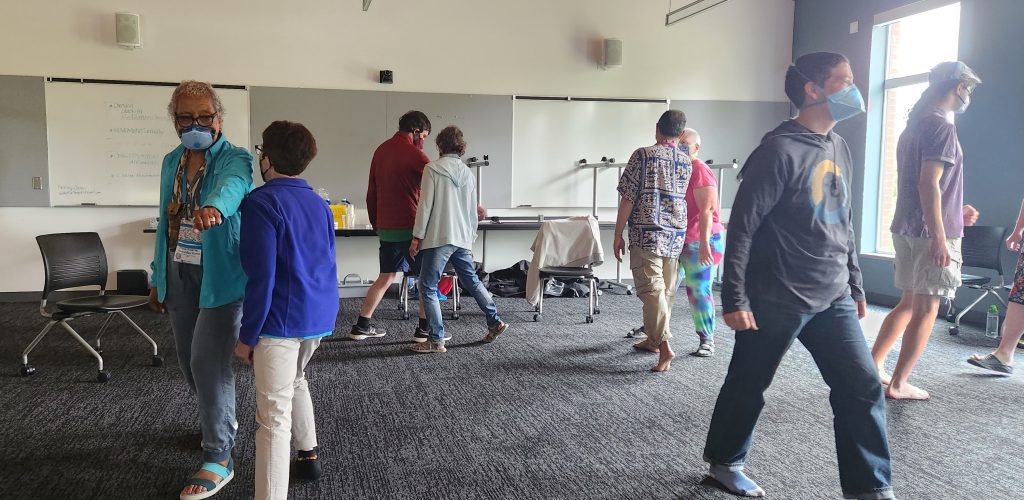
Everyone quickly connected with their partners and we practiced with just one step. During the debrief one person shared that their health care provider had demonstrated a stepping back technique that they had used to engage in a conflict, but that stepping in hadn’t even occurred to them. They asked themselves, “How could I make use of that in my situation?” they asked themselves.
I talked about and demonstrated – with my F/friend who was a great demo partner – how being in close is safer and not at all threatening to the other person: it’s simply in close and connected.
Then we moved on to a form of Ushiro Irimi that Ito calls, “Welcome, this way please.”
This 7 second video show me and Connie Borden demonstrating it. Ito describes this as going to the front door to greet a visitor, then opening the door and guiding them inside. I especially love this kumite.
Perhaps it’s because I was so incredibly slow to be able to demonstrate it. It took me years. In fact, Ito tried using different names, taught it several times in the Bay Area, and organized a workshop that I later realized was specifically for me! I was able to teach this to people who had no martial arts experience in a few minutes, so I think I finally get it.
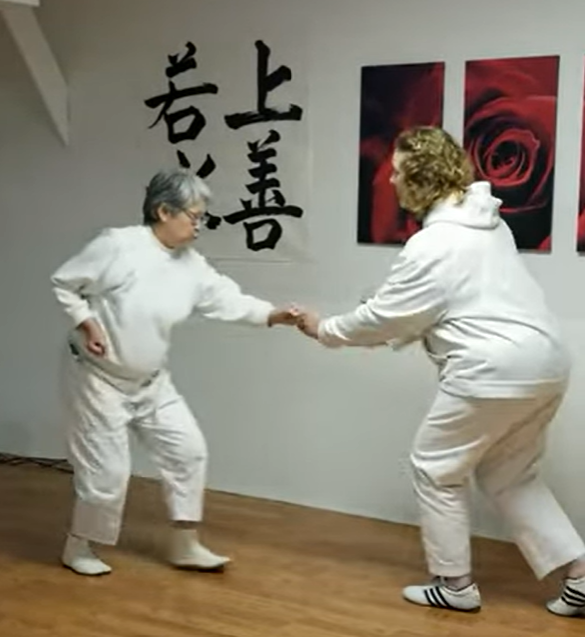
During our debrief I shared what Ito says about literally sharing the same perspective as your opponent, standing shoulder to shoulder – and the game changing attitude of welcoming the person who is attacking.
I think it was hard for Friends to understand the value and importance of a sincere attack: Friends tend to be conflict averse (or passive aggressive!) so tsuki was a bit challenging.
During one of our large group conversations there was a long silence and the group naturally dropped into worship sharing — a time during which people can speak out of the silence on a particular topic. It was wonderful that everyone was so comfortable with silence – not something I ever experienced as a meeting facilitator since groups expect a meeting to be filled with talk.
It was fascinating to navigate across my experiences of meeting facilitation, gorei and worship leading – especially when these distinct practices overlap.
One big takeaway was how tiring it is to undertake a gasshuku without the support of a director of instruction or any sensei care. Outside of Shintaido and Japanese culture, no one thinks about such things. I did just submit a proposal to offer the workshop again next summer and this time I will make sure someone comes to support me! Stay tuned for a Body Dialogue update next year.
*Religious Society of Friends (also known as Quakers)

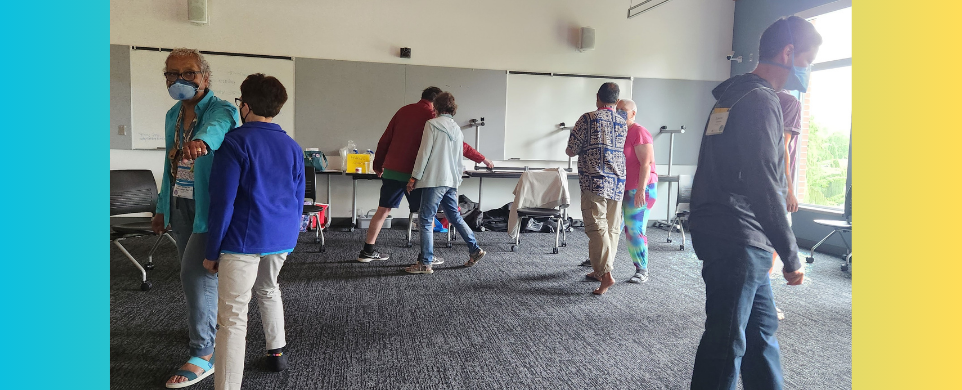


Thank you Tomi for your teaching, your passion and your insights. I hope they do accept your proposal for next year.
Connie
Thank you Tomi! This article definitely speaks to my condition (as English – perhaps not only English?) Friends say. A couple of years ago Carina Hamilton (another English Friend and Shintaido instructor) planned a program for introducing Shintaido to Quakers via Zoom. It got pulled, but the planning was very rich, and maybe we can revive it sometime.
Thanks Tomi for your insights that integrate Shintaido keiko with Friends’ practices and trauma/ conflict management. This is an exciting interface that has challenged me for years. I hope to lead a similar workshop at my local Worcester Friends Meeting soon. I was surprised to see similar connections being made at a training for AVP (Alternatives to Violence Project) facilitators at a Quaker conference center in NY a few years ago. We practiced basic irimi moves under the guidance of a Native American Aikido Master Instructor. Unfortunately I haven’t been allowed to implement such practices here in Massachusetts prisons, as AVP volunteers aren’t supposed to do much touching with inmates (a very traumatized population) other than handshaking.
1 question : what is the “panic/ rock “ exercise?
Matt Shorten
Thank you Connie, Peter and Matthew for your encouraging comments.
This translation of Shintaido for general audiences – what Ito calls “Shintaido software” – has been going on for a long time. Ito – and Connie – created a curriculum for caregivers that was well-received, and several instructors have used and written about Shintaido for specific audiences.
I wish that this would migrate from the fringes closer to the center of our practice and teaching, in the same way that Ito has been rediscovering and reclaiming Yokikei keiko. Perhaps after I enter my second retirement (I’m taking a break from retirement to work), I will organize a gasshuku to gather folx interested in this approach.
Matt – to your question about “panic and rock,” they’re physical examples of ways humans tend to respond to stress – holding our breath and drawing shoulders up (panic) and hunkering down and holding our bodies tightly (rock). They’re a great contrast and introduction to Wakame and Bamboo.
If you have an AVP co-facilitator you could demonstrate on one another to show the ineffectiveness of tenseness and the effectiveness of Wakame and Bamboo – while everyone else practices singly.
Yours in community,
Tomi
Thanks!